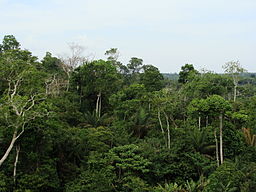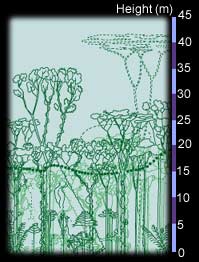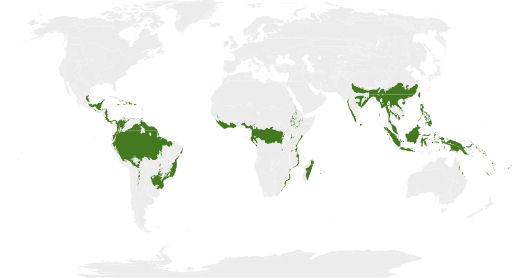Biosphere Contents
6. Biomes
The tropical rain forest biome contains the most diverse terrestrial communities on the globe

Rainfall is very high throughout the year - between 1250 and 12,500 mm, with at least 60 mm in each month - often as violent thunderstorms. Temperatures are almost constant throughout the year, typically with greater variation between day and night (3-7°C) than between different seasons (annual temperature range of around 2°C). As neither temperature nor rainfall is a limiting factor on plant growth, rain forest is characterised by very high species diversity, with up to 329 different tree species recorded per hectare (Laurance 2010). There have been 1,209 species of butterfly documented in the 55 km2 Tambopata Reserve in SE Peru, this compares to the 380 species found in the whole of Europe and North Africa combined (Forseth 2012). This is why many debates about biodiversity concentrate on the tropical rain forest.
Despite the abundant vegetation they support, tropical rain forest soils tend to be very poor, with low nutrient levels. The heavy rainfall can cause high rates of leaching which may leave behind large residues of iron and aluminium oxide. Most of the nutrients are tied up in the biomass, and as animals die and leaves and trees fall, the nutrients released are very quickly taken up again by the shallow tree roots, leading to rapid nutrient cycling.

|
The trees are characteristically very tall, and form a dense canopy at heights of around 100 feet, which lets little light through to the forest floor. Some species are understorey specialists, while others are emergents that break through the canopy. Roots are often very shallow and the roots of many species develop thick buttresses to support the trunk as the tree ages. Epiphytic plants grow on the upper reaches of the trees. |
|
The leaves of most species are similar in shape, many having well developed drip tips, an adaptation which allows the leaf to shed water and dry quickly after rainfall. If it were to stay wet it may rapidly be colonised by fungi or bacteria, preventing photosynthesis or making the leaf more vulnerable to being eaten by herbivores. |
.jpg)
|
Tropical rain forests occur between the Tropics of Cancer and Capricorn: the most extensive are in South America in the Amazon and Orinoco basins and the Central American Isthmus; extensive forests are also found in the Congo basin of Central Africa; along the coastal fringe of Western Africa; and across South-East Asia and New Guinea.
What are the main characteristics of the tropical rain forest biome?
